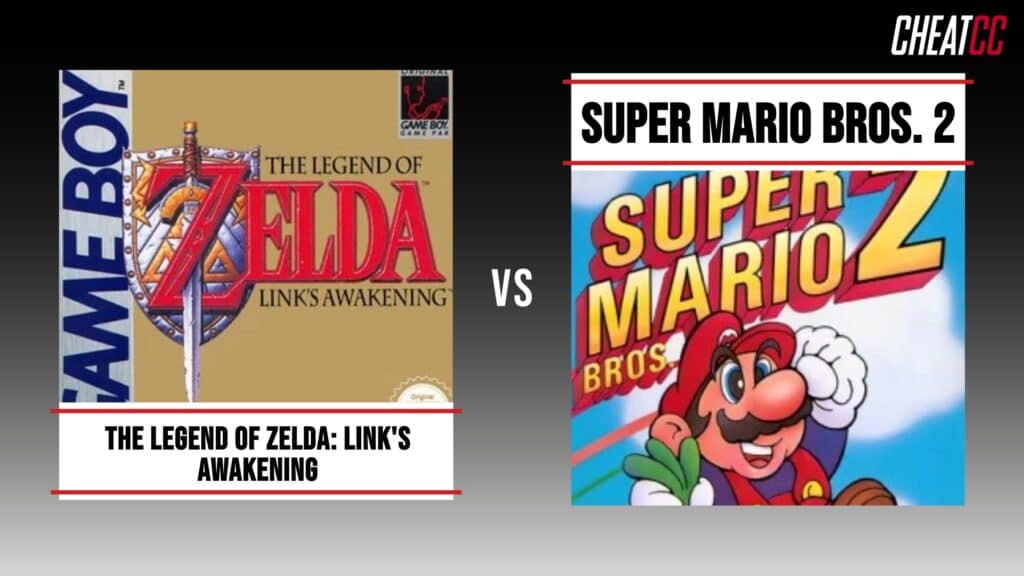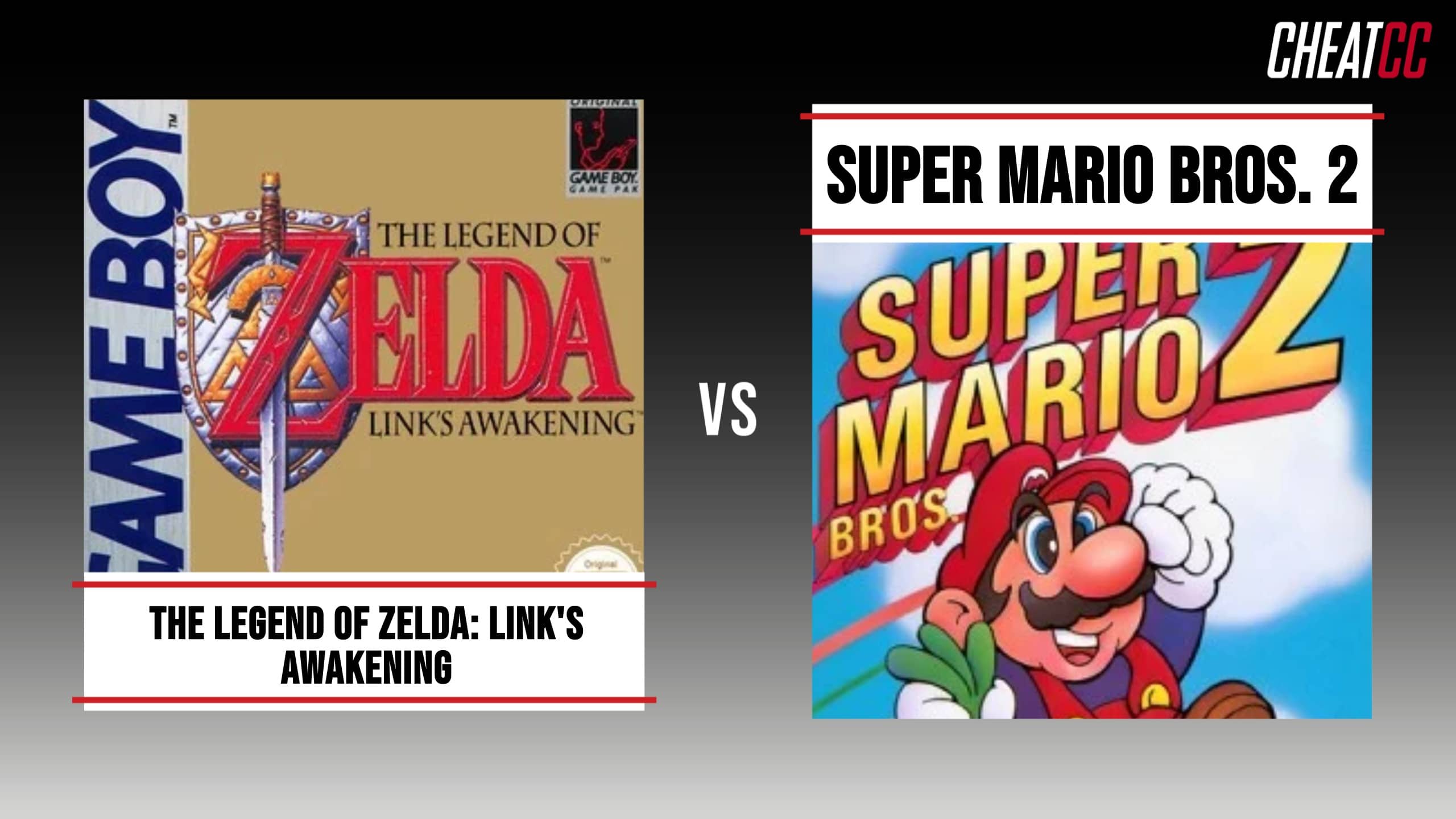Though it might not appear like it at first glance, The Legend of Zelda: Link’s Awakening and Super Mario Bros. 2 actually share something in common. Yes, both titles are sequels to popular Nintendo games and are part of two of Nintendo’s flagship franchises, but the connection that these games share traces back to the framing device of each title’s narrative. Anyone who has ever beaten either Link’s Awakening or Super Mario Bros. 2 should recall that the plot of each game takes place within a dream of both series’ main protagonists, Link and Mario, making the events of each title a figment of the main character’s subconscious. With both games essentially serving as extended dream sequences, it’s time to pit Link’s Awakening vs Super Mario Bros 2 to see which is the better game.
Of course, comparing these two titles is tantamount to comparing apples and oranges, with one a complex action-adventure title and the other a classic platformer in the vein of the other 2D Mario games. That said, Super Mario Bros. 2 is radically different from the other two NES-era Mario titles thanks to its origins as a completely different title retrofitted to the Super Mario license. The same holds true for Link’s Awakening, which takes the hero out of the traditional setting of Hyrule for the first time and transplants him as a marooned traveler on Koholint Island. Ultimately, both games explain away their mysterious differences from other series titles as it all being part of a dream.
Link’s Awakening vs Super Mario Bros. 2: Side-by-Side Comparison

Aside from both games being first-party Nintendo titles and entries in the company’s flagship franchises, there’s not much on the surface that connects Link’s Awakening and Super Mario Bros. 2. The original Super Mario Bros. 2 (which would later release in the West as Super Mario — The Lost Levels) would prove to be too difficult for American players, prompting Nintendo to retrofit an entirely different game with Super Mario characters like Mario, Luigi, Toad, and Princess Peach. Conversely, Link’s Awakening would end up being the first Zelda title for the Game Boy and would feature much of the same team behind the SNES’ The Legend of Zelda: A Link to the Past, remaining the same game regardless of region. However, despite their differences, both Link’s Awakening and Super Mario Bros. 2 take place within the imaginations of their protagonists.
| Characteristic | Link’s Awakening | Super Mario Bros. 2 |
|---|---|---|
| Release Year | 1993 | 1988 |
| Release Platform | Game Boy | NES |
| Producer | Shigeru Miyamoto | Shigeru Miyamoto |
| Series | The Legend of Zelda | Mario |
| Setting | Koholint Island | Subcon |
| Regional Differences | N/A, same game in both Japan and North America | NES release of Super Mario Bros. 2 is actually a reskin of the game Doki Doki Panic |
| Review Aggregate Score | 90% | 81% |
| Total Sales | 3.83 million units | 7.46 million units |
| Ports, Remakes, Remasters | Multiple Virtual Console ports, 1 Remaster (Link’s Awakening DX) and 1 Remake | Multiple Virtual Console ports, 2 Remasters (Super Mario All-Stars and Super Mario Advance) |
| Available on Nintendo Switch | ✅ | ✅ |
| Entire Game is a Dream Sequence of Main Character | ✅ | ✅ |
Link’s Awakening vs Super Mario Bros. 2: 5 Must-Know Facts
Here are 5 must-know facts when comparing Link’s Awakening to Super Mario Bros. 2:
- The initial release of Link’s Awakening on Game Boy is the same game regardless of region, with the Japanese and North American versions having no discernable differences. Super Mario Bros. 2, on the other hand, is a completely different game on the NES than the version that would release on the Famicom in Japan.
- Both Link’s Awakening and Super Mario Bros. 2 are part of a long list of pop culture media in which the framing device for the core narrative is that it’s all a figment of the main character’s imagination or a dream. Link’s Awakening keeps this hidden until the game’s ending while Super Mario Bros. 2 acknowledges it outright.
- Though Super Mario Bros. 2 has a much lower review aggregate score than Link’s Awakening and is the “black sheep” of the NES Mario trilogy, it is one of the best-selling games on the console and has more than double the commercial success of Link’s Awakening.
- Legendary game designer and Nintendo employee Shigeru Miyamoto is the creator of both Super Mario Bros. and The Legend of Zelda, so it should come as no surprise that he reprises his role as series producer for both Link’s Awakening and Super Mario Bros. 2, heavily guiding the direction of both games’ development.
- Super Mario Bros. 2‘s success would guarantee that it go down as one of the all-time classics in the NES library, resulting in the game receiving not one but two remasters on the SNES and GBA. Link’s Awakening would receive a single remaster on Game Boy Color only to then later be the recipient of a full ground-up remake on Nintendo Switch.
Link’s Awakening vs Super Mario Bros. 2: Regional Differences
Japanese players know Super Mario Bros. 2 as a game that largely resembles the 1985 original Super Mario Bros., only it’s significantly more difficult. While this “true” version of SMB2 would arrive in the West years later as Super Mario — The Lost Levels, the difficulty of the game would prompt Nintendo to develop an alternate version for Western players. This would lead to the retrofitting of Mario assets into the Japanese-exclusive Famicom game Doki Doki Panic, meaning that the NES version of Super Mario Bros. 2 is a completely different game from the original Japanese version. In fact, the NES version of Super Mario Bros. 2 would later release in Japan as Super Mario USA.
No such regional differences exist between the various localizations and the original release of Link’s Awakening. Development on this now-classic Zelda title would begin shortly after the release and success of Link’s Awakening as an effort to translate that game’s core experience into a handheld title for the Game Boy. As a result, several of the core developers on A Link to the Past would return for Link’s Awakening, resulting in a game with a very clear design philosophy underpinning it that remains consistent across all versions.
Link’s Awakening vs Super Mario Bros. 2: The “Dream Sequence” Trope
From classic television dramas like Dallas to more contemporary arthouse esoteric series like Twin Peaks, the subject of dreams and the use of a dream sequence as a framing device for an alternate reality story is a popular trope. In fact, the developers of Link’s Awakening are on record citing Twin Peaks as a direct influence on the game, with the intention always being for the title to be drastically different from other Zelda games and take place entirely within Link’s psyche. Super Mario Bros. 2 also takes place entirely within a dream, but the player receives hints about this throughout the game whereas it comes as a surprise in the ending reveal of Link’s Awakening. Come to think of it, though, the title does tend to give this plot point away.
Link’s Awakening vs Super Mario Bros. 2: Sales and Reception
Until the more recent runaway successes of both Breath of the Wild and Tears of the Kingdom, the Legend of Zelda games have traditionally undersold when compared to the games in the Mario series. This holds true for nearly every Nintendo hardware generation, with the Mario titles having a comparatively broader mainstream appeal. Link’s Awakening would eventually sell almost 4 million copies on Game Boy and help to increase sales of the console by 13%, but it still only has half the total sales of Super Mario Bros. 2. On the other hand, the critical reception to Link’s Awakening is much stronger at a respectable 90% review aggregate score against Super Mario Bros. 2‘s 81%.
Link’s Awakening vs Super Mario Bros. 2: Remakes and Remasters
It’s usually a clear indicator of a game’s popularity if it receives ports to other consoles and remasters or a remake, as it shows there’s still an audience for a classic title that wants to play it on more accessible hardware. Both Link’s Awakening and Super Mario Bros. 2 have plenty of ports available, with each title receiving multiple re-releases on the various Virtual Console services across Nintendo’s hardware. Additionally, both Link’s Awakening and SMB2 have been recipients of remasters, with Link’s Awakening getting its full-color version on the Game Boy Color with Link’s Awakening DX and SMB2 getting a 16-bit upgrade as part of both Super Mario All-Stars and Super Mario Advance. That said, Link’s Awakening is the only game out of the two that has a full remake available on the Nintendo Switch.
Bottom Line
The sequels to the marquis releases in the NES library would all experiment with the formula that their predecessors established, with both Super Mario Bros. 2 and Zelda II being drastic departures from the games kickstarting their respective franchises. As game devs continued to find their footing and discover the kind of experiences possible on the console, these growing pains would result in some games that continue to be polarizing, but among them, Super Mario Bros. 2 is at least incredibly commercially successful and one of the best-selling games on the NES.
But even though Super Mario Bros. 2 outsells Link’s Awakening, it doesn’t hold a candle to one of the best 2D Zelda games of all-time. In terms of which “dream sequence” game is the better first-party Nintendo game, Link’s Awakening is the clear frontrunner thanks to the cohesiveness of its design and its adoption of A Link to the Past‘s gameplay.
